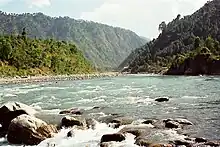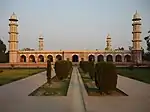
| Part of a series on |
| Punjabis |
|---|
 |
_with_cities.png.webp) Punjab portal |
Majha (Punjabi: ਮਾਝਾ (Gurmukhi), ماجھا (Shahmukhi); Mājhā; meaning "heartland[1]) is a region located in the central parts of the historical Punjab region split between India and Pakistan.[2][1] It extends north from the right banks[note 1] of the river Beas, and reaches as far north as the river Jhelum.[3] People of the Majha region are given the demonym "Mājhī" or "Majhail". Most inhabitants of the region speak the Majhi dialect, which is the basis of the standard register of the Punjabi language.[4] The most populous city in the area is Lahore on the Pakistani side, and Amritsar on the Indian side of the border.
During the partition of India in 1947, the Majha region of Punjab was split between India and Pakistan when the Indian Punjab and Pakistani Punjab were formed. The Majha region of Indian State of Punjab covers the area between Beas and Ravi rivers, including the area on the north of Sutlej, after the confluence of Beas and Sutlej at Harike in Tarn Taran district, extending up to the Ravi River, which is all part of the Majha region in India.[5] This region contains fourteen districts of the Pakistani province of Punjab, including the cities of Lahore,Pakpattan, Gujranwala, Gujrat, and Sialkot. It includes four districts of Indian state of Punjab – Amritsar, Tarn Taran, Gurdaspur, and Pathankot.
The people of the Majha region have been historically known for their warrior-like nature. The Majha region is called the "Sword Arm of the Country", due to it contributing disproportionately to the Officer as well as Orderly ranks of the Armies of both India and Pakistan.[6] The Sikh Empire was founded in the Majha region, and so the region is also sometimes referred to as "the cradle of the brave Sikhs".[7] Majha is also the birthplace of Sikhism.[8]
History

The word "Mājhā" means the "central" or the "heartland". The Majha region is geographically located in the middle (or central part) of the historic Punjab region, hence giving it the name Majha.[9] It includes a considerable portion of the Bari Doab (the region between the rivers Beas and Ravi) and the Rechna Doab (the region between the rivers Ravi and Chenab), and a smaller portion of the Jech Doab region (the region between the rivers Jhelum and Chenab).[10]
The Majha region of historical Punjab region spans northward from the right banks[note 1] of river Beas, and extends up to river Jhelum at its northmost,[3] making it the largest regions of historic Punjab.
The Indian state of Punjab has continued to recognize the Majha region through maintaining the districts that have historically belonged to the Majha region. In Pakistan, the Majha city of Lahore was selected as its provincial capital, which the remaining Majha districts were either maintained, or their borders blurred as the boundaries were divided between districts Bahawalpur, Dera Ghazi Khan, Multan, and Rawalpindi,[11] Sahiwal and Sargodha.
Districts of Majha
The following districts are classified as Majha.
| Majha districts of Punjab, India | Majha districts of Punjab, Pakistan | ||||
|---|---|---|---|---|---|
| Amritsar | Lahore | ||||
| Gurdaspur | Gujrat | ||||
| Tarn Taran | Pathankot | Narowal | |||
| Okara | Kasur | ||||
| Gujranwala | Sialkot | Mandi Bahauddin
} Tourist attractionsIndia The Harmandir Sahib (Golden Temple), Amritsar
Pakistan Badshahi Masjid, Lahore
Notable residents Of Majha
Noor Jahan, Singer, real Name Allah Rakhi, Kasur Photo gallery
See alsoNotesReferences
|




.jpg.webp)




